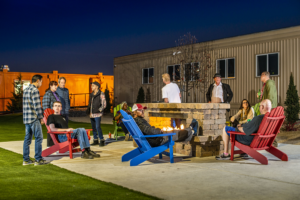 The Village on Sage Street is a 216-unit, dorm-style housing project for people who are working but struggling to afford rent. The property responds to an urgent need for affordable rental housing in Reno, a city suffering from a housing crisis. The recently completed Truckee Meadows Regional Strategy for Affordable Housing estimates that the area needs 40,135 additional affordable units.
The Village on Sage Street is a 216-unit, dorm-style housing project for people who are working but struggling to afford rent. The property responds to an urgent need for affordable rental housing in Reno, a city suffering from a housing crisis. The recently completed Truckee Meadows Regional Strategy for Affordable Housing estimates that the area needs 40,135 additional affordable units.
In addition to the need for new affordable housing, rents for the existing housing stock have increased rapidly. From 2013 to 2019, rents increased by 42 percent when adjusted for inflation. In 2016, Reno was among the top three metropolitan areas for rent increases and in 2017, it was the city with the fourth-highest rent increase in the United States. In addition, no-cause evictions have increased by 300 percent between 2012 and 2017. In 2018, an estimated 3,500 individuals were living in weekly motels, and over one-third of residents are rent burdened, spending more than 30 percent of their household income on rent.
The Village came to fruition because of private and public entities. Local developers identified modular units that could be repurposed for affordable housing and the city of Reno donated the land. Numerous individuals and companies donated funds and many companies provided in-kind support to make the Village a reality. The Village is also self-sustaining: the development was funded by private contributions without any subsidies and the $400 monthly rents cover operating expenses.
The Village is on a four-acre (1.6 ha) property in downtown Reno by the railroad tracks, which was donated to the Community Housing Land Trust by the city of Reno. Many new businesses have opened in recent years, helping revitalize the area. The Village on Sage Street is conveniently located on the Regional Transportation Commission’s Rapid Lincoln Line. Only 29 percent of residents own their own vehicle, so the transit-oriented location is critical for those who need to get to work and conduct other activities.
The Village consists of eight modular buildings, with dorm-style apartments. Each room comes furnished with a twin bed, a wardrobe, a desk, and a small television. There is a recreation building with a gym, a mail room, a lounge area, and a computer room. All buildings have Wi-Fi for residents to use. The dining building is located in the middle of the four standard dorm buildings in which a local bakery operates a small market selling fresh salads and sandwiches, frozen and canned goods, and basic toiletries. The dining building has ample seating, tables, couches, and a television. While not everyone is going to be interested in dorm-style living, the Village is a safety net for people in the community who may otherwise be faced with living on the streets, in their car, or couch-surfing. As residents secure other housing, find roommates, or reach the top of a subsidized housing waiting list, they will be able to move out. In the meantime, rents represent at most one-third of their monthly income, so they have the opportunity to save money or pay down debt.
Location: Reno, Nevada
Developer: The Community Housing Land Trust, a limited liability company of the Community Foundation of Western Nevada
Owner: Volunteers of America Northern California and Northern Nevada
Development partners: The city of Reno, Q&D Construction, Summit Engineering, Helix Electric, Group West Construction, Pezonella Associates, Par Tolles, Allison Gorelick, and Dan Carne
 The Village on Sage Street is a 216-unit, dorm-style housing project for people who are working but struggling to afford rent. The property responds to an urgent need for affordable rental housing in Reno, a city suffering from a housing crisis. The recently completed Truckee Meadows Regional Strategy for Affordable Housing estimates that the area needs 40,135 additional affordable units.
The Village on Sage Street is a 216-unit, dorm-style housing project for people who are working but struggling to afford rent. The property responds to an urgent need for affordable rental housing in Reno, a city suffering from a housing crisis. The recently completed Truckee Meadows Regional Strategy for Affordable Housing estimates that the area needs 40,135 additional affordable units.